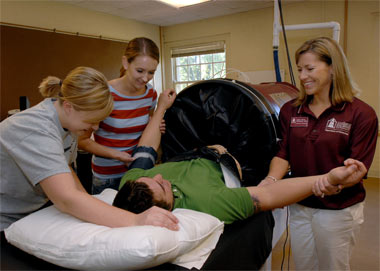
Under pressure — Kinesiology students (from left) Allison M. Jurgens of Ashland, Amy N. Phegley of Mt. Carmel and Eric M. Spenner of Nashville help Assistant Professor Juliane P. Hernandez (right) demonstrate her lower body negative pressure chamber in Hernandez’ lab on the Southern Illinois University Carbondale campus. The chamber, made from a sewer pipe and designed by Hernandez’ father, an aeronautical engineer, helps Hernandez study how people regulate their blood pressure. (Photo by Russell Bailey) Download Photo Here
August 06, 2008
Device helps physiologist study blood pressure
CARBONDALE, Ill. -- You know that lightheaded, dizzy feeling you get when you stand up too fast? With the help of a machine built from a sewer pipe, Juliane P. Hernandez can make you feel just like that when you’re lying flat on your back.
Why would she do that, you might ask. Hernandez, an exercise physiologist at Southern Illinois University Carbondale, uses this machine and others in studying how our bodies regulate our blood pressure from one heartbeat to the next.
She will talk about her work at noon Wednesday, Oct. 15, in Room 219 of Wham Education Building on the SIUC campus as part of the College of Education and Human Services’ free brown bag lecture series. Those attending may bring their lunches; the dean’s office will provide light refreshments.
Despite its importance to human health, scientists have difficulty studying blood pressure because in this instance the animal models on which they generally rely don’t work.
“With rats and dogs, 70 percent of their blood volume is at or above the level of their hearts when they’re standing up,” Hernandez said. “With humans, 70 percent of their blood volume is below their hearts.”
Hernandez’ lower body negative pressure chamber (a.k.a. the sewer pipe) uses suction to pull blood from the upper half of the body to the lower half, causing blood pressure to fall and mimicking what happens when we stand. The dizzy feeling occurs as the brain reacts to the loss of blood volume and the resultant drop in blood pressure.
“Some people experience this to a detrimental degree -- they pass out,” Hernandez said.
“Why doesn’t this happen to everyone all the time? Because most of us have reflexive responses that help get blood back into the brain within a second or two -- we regulate our blood pressure.”
Hernandez is focusing on the physiological processes involved when people compensate for the drop caused by standing. Because her pressure chamber allows her to control the flow of blood so completely, she can record minute pressure changes in arteries and veins as the heart beats. She also can track, beat to beat, what happens in the heart and the brain as the volume of blood changes.
“If we can understand what causes blood pressure to reset to that higher point, we might then be able to understand the mechanisms causing high blood pressure in general,” Hernandez said.
While scientists don’t know what causes high blood pressure, they do know that age and physical inactivity play a role.
“As we age, the blood vessels don’t contract and expand as easily -- they’re stiffer, less stretchy,” Hernandez said. “It takes more pressure to circulate the blood through that smaller opening.”
While we can’t change our ages, we can boost our levels of physical activity, and that does affect blood pressure — almost instantly.
“After one bout of exercise, your blood pressure will go down to a lower point after you’ve cooled down than it was when you started,” Hernandez noted.
“It’s generally transient. If you don’t exercise the next day, it will probably go back up, but over the long haul, exercise will bring your resting blood pressure down.”
With those effects in mind, Hernandez is also looking at how age and fitness affect the body’s ability to regulate its own blood pressure. She’s running her tests on young folks and old ones, athletes and couch potatoes and comparing their physiological responses. She’s also interested in looking at the responses of different races as African-Americans generally have more problems with high blood pressure than do members of other groups.
Increased understanding of the mechanisms of blood pressure regulation will help doctors as they prescribe medications, particularly for older people, Hernandez said.
“For example, we know that exercise alters blood pressure, which suggests it also changes what’s needed in a prescription,” she noted.
“If we understand how those changes progress, we can treat not just for the immediate condition but for the long term.”
